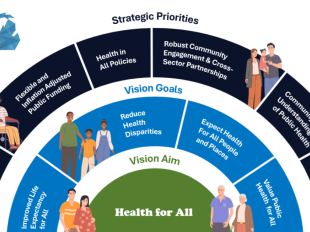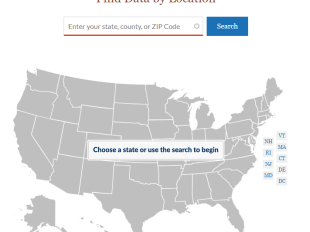Kansas Health Institute: making health data accessible and digestible
Organizations around the country are presenting data that support action to improve health and equity.
One of those organizations is The Kansas Health Institute (KHI), a nonprofit, nonpartisan educational organization with the mission of creating a healthier Kansas through policy. KHI senior analyst Wyatt Beckman has been presenting County Health Rankings & Roadmaps’ new data visuals in a novel way to help educate Kansans about their counties’ health. In 2024, CHR&R started assigning each county to a data-informed group, replacing the ordinal rank where each county had a unique number from healthiest to least healthy. Beckman recently joined CHR&R’s webinar to share how he makes county health and equity data accessible and digestible, whether presenting to policymakers, health departments or the general public.
KHI creates County Profiles every year to coincide with CHR&R’s Annual Data Release. Each two-page summary includes a county’s snapshot of health outcomes and health factors to illustrate how it compares to others in the state. Along with data for the current release, KHI also presents trends by including data for the previous five years. Measures creating the biggest impact on the county’s grouping are highlighted as either positive or negative drivers of health.
(View an example of Allen County, KS here)
While ordinal ranks provide a simple number that emphasizes the differences between counties, the approach reinforces a dominant narrative that one county must be better or worse than another. In other words, if a county moves from first to second, one county’s loss is another county’s gain. In some cases, the differences between ordinal ranks are not meaningful.
The data-informed groups, on the other hand, provide a way to consider a county’s health relative to others, while also making it easier to see the similarities and potential connections between communities. Along with CHR&R’s Compare Counties tool, users can now identify counties experiencing similar health outcomes or factors across the country, not just within their state. This helps move us toward a narrative that focuses on connectedness and possibility: We can work together to improve health and equity.
“When given the opportunity to understand and digest the change, they see the advantages. When I present and talk about the Rankings, I emphasize what hasn’t changed. And I try to really build on what they already know and work to make those connections to how they can utilize this information,” Beckman said about addressing the removal of ordinal rankings from CHR&R data during the October webinar. “We have a new ability to compare across counties. And once I’m able to explain that I think the new approach resonates well.”
State legislators are another key audience. Every year, KHI hosts an event at the capitol in Topeka, Kansas, to hand out breakfast and packets with maps and County Profiles representing lawmakers’ constituents.
When a few legislators this year asked where their rank went, Beckman and his colleagues leaned into the conversation.
“It was an opportunity to encourage folks to move beyond that individual snapshot and really look at the individual measures and use those to track progress. And, to start conversations about shared strategies and shared challenges,” Beckman said.
For more information, watch the webinar recording and read about the new data approach here.



